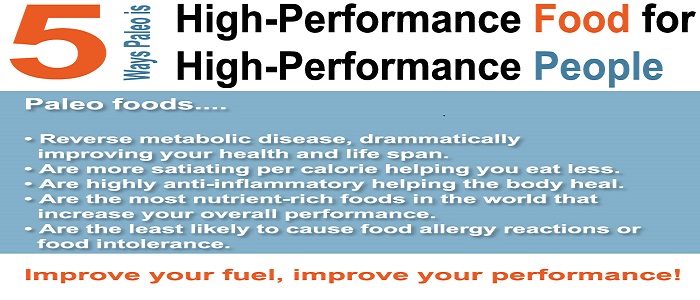
High performance people need high performance food. It's as simple as that. If you're not giving your body and brain the right nutrients, you'll under-perform and likely get sick.
Today's convenience food simply isn't good enough for people who have a lot of goals and a large helping of stress to go with it.
If you want to keep your engine fueled properly, it pays to be aware of the best foods on Earth. Here is a good example of exactly how Paleo foods can benefit a high-performance person – perhaps a person needs to improve or prevent a condition that they might need to manage. For this example, let's say they need to lower their blood cholesterol.
The typical advice for that person is to strictly limit meat and milk fats. While dairy isn't on the Paleo diet, limiting meats in the extreme may not sit well for some people. So, while we know that limiting meat is effective for lowering cholesterol, it's also a very unpopular option!
With knowledge of various Paleo foods, you become aware of interesting options. Instead of blatantly removing all meats from the diet, you become aware of alternatives you might not have known about before. Alternating the diet with leaner types of meat you most likely have never experienced before will give a new light down the tunnel, keeping you on the right track. These tasty (and often exotic) alternatives will also give you something to look forward to when you allow yourself treats.
So without further adieu, let's get into the meat of this matter. Let's take a look at the various foods on the Paleo diet. This consists of meats, fruits and vegetables, nuts and seeds, and certain oils and fats. These are the foods that are ideal to start with, for turbo charging your body for optimal health and performance for several reasons. For example, if you're fine with cheese (60% of the world's population isn't), you can add that later, in moderation, after you've determined that dairy is indeed not causing you any issues.
Here Are Five Major Reasons The High-Performance Individual Will Get More Out of Eating a Paleo Lifestyle:
1) Paleo foods are known to have the potential to reverse the epidemics of metabolic and cardiovascular disease. Randomized clinical trials (which is the gold standard of medical evidence) regularly show that people eating a Paleo lifestyle have reduced their weight, waist circumference, a variety of lipid markers, like total cholesterol and HDL cholesterol, body mass index, blood pressure, blood sugar, and inflammatory markers like C reactive protein.
2) Paleo foods are more satiating per calorie than the low fat diet. Basically, when you eat Paleo foods, you feel more full, and when you feel more satisfied, you naturally eat less. Your body becomes leaner without trying and you’re much more likely to stick with the lifestyle for the long haul.
3) Paleo foods are highly anti-inflammatory. Pain, obesity, diabetes, thyroid issues, heart disease, stroke, migraines, and cancer are all disorders dealing with chronic inflammation. When you're a high-performance person under more stress than others, it pays to have this nutritional insurance against inflammation.
4) Paleo foods are the most nutrient-dense foods in the world. Calorie to calorie, gram to gram, Paleo foods have the most bio-available nutrients than non-Paleo foods by a long shot. This clearly gives the high-performance individual an edge.
5) Paleo foods are the least likely to cause food allergy reactions or food intolerance. This is an important point to take note of when 2 million Americans have celiac disease, and yet 1.5 million of them don't even know they have it.
Understanding The History of Paleo Foods
One of the things to clear up is why we call this the “Paleo lifestyle”. It has nothing to do with digging up grubs, eating crickets, or eating only meat. The bottom line is that the Paleo lifestyle simply takes out processed foods and foods that are known to be irritating to the body.
We use the name “Paleo diet” based on findings from our Paleolithic past, and take that knowledge and apply it towards our modern eating habits. Biologically speaking, we modern humans are the same as our ancestors in the Paleolithic Era.
They had ten million years to evolve into the machine we are today, and ten million years is a long time to make sure the body is perfectly adapted to certain foods. This is why we stick to basic meats, nuts, fruits and vegetables in the Paleo diet. These are the foods archaeologists have researched and found that Paleolithic men ate.
Where's the dairy, beans (legumes), and grains? Those foods were only introduced a mere 4,000 years ago, and were mostly introduced in the Neolithic Era when agriculture and the domestication of animals (for dairy) became common place. All sorts of health issues also started showing up during the Neolithic Era that didn't ever happen in our Paleolithic ancestors.
Not something to ignore, but at the same time we must use common sense with our approaches to food choices. Keep in mind that everyone is different and nothing is as simple as black and white with regards to your diet. In essence, listen to what your body is telling you.
The Paleo diet is an excellent tool to get the most out of your food. If you're battling with a condition, or if you just want to optimize your health and energy, the Paleo diet is an excellent start!
About the Author

Twitter: https://twitter.com/originaleating
Facebook:https://www.facebook.com/PaleoOriginalEating
Pinterest:https://www.pinterest.com/oeating/

